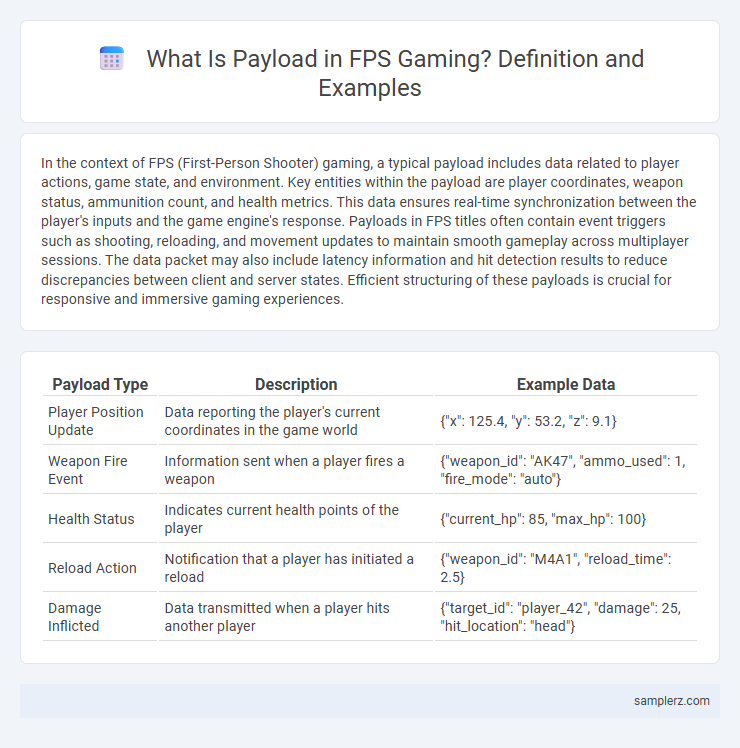In the context of FPS (First-Person Shooter) gaming, a typical payload includes data related to player actions, game state, and environment. Key entities within the payload are player coordinates, weapon status, ammunition count, and health metrics. This data ensures real-time synchronization between the player's inputs and the game engine's response. Payloads in FPS titles often contain event triggers such as shooting, reloading, and movement updates to maintain smooth gameplay across multiplayer sessions. The data packet may also include latency information and hit detection results to reduce discrepancies between client and server states. Efficient structuring of these payloads is crucial for responsive and immersive gaming experiences.
Table of Comparison
| Payload Type | Description | Example Data |
|---|---|---|
| Player Position Update | Data reporting the player's current coordinates in the game world | {"x": 125.4, "y": 53.2, "z": 9.1} |
| Weapon Fire Event | Information sent when a player fires a weapon | {"weapon_id": "AK47", "ammo_used": 1, "fire_mode": "auto"} |
| Health Status | Indicates current health points of the player | {"current_hp": 85, "max_hp": 100} |
| Reload Action | Notification that a player has initiated a reload | {"weapon_id": "M4A1", "reload_time": 2.5} |
| Damage Inflicted | Data transmitted when a player hits another player | {"target_id": "player_42", "damage": 25, "hit_location": "head"} |
Understanding Payload Objectives in FPS Games
In FPS games, a payload typically refers to a moving objective that teams must escort or stop, such as a bomb cart or a data transmission device. Understanding payload objectives involves tracking the payload's position on the map, coordinating team movements to either protect or contest the payload, and timing attacks or defenses to align with critical moments in the push. Mastery of payload mechanics influences map control and can heavily dictate the pace and strategy of competitive FPS matches.
Classic Payload Missions in Popular FPS Titles
Classic payload missions in popular FPS titles such as Team Fortress 2 and Overwatch involve teams escorting a movable objective, often a cart or vehicle, through a series of checkpoints to reach a final destination. The payload typically contains important in-game items or explosives, requiring attackers to maintain continuous control while defenders attempt to halt progress. These missions emphasize strategic positioning, teamwork, and timed objectives, creating dynamic gameplay scenarios that significantly influence match outcomes.
Notable Payload Maps and Their Impact
Notable payload maps in FPS games, such as "Payload" in Team Fortress 2 and "King's Row" in Overwatch, have significantly influenced game design by integrating objective-based strategies with fast-paced combat. These maps require teams to escort or prevent the payload from reaching checkpoints, promoting teamwork and tactical depth. Their impact is evident in the growing popularity of hybrid game modes that blend payload objectives with traditional deathmatch elements, enhancing player engagement and competitive balance.
Payload Escort: Tactics and Strategy
Effective payload escort tactics in FPS games revolve around balancing aggressive offense with strategic defense to ensure continuous movement. Coordinated team efforts to control key choke points and suppress enemy ambushes maximize payload progression speed. Utilizing abilities that provide shields, healing, or crowd control creates openings for teammates to push the payload safely under heavy opposition.
Iconic FPS Payload Game Modes Explained
Payload game modes in iconic FPS titles like Team Fortress 2 and Overwatch challenge players to escort or defend a moving objective across the map, blending strategic teamwork with fast-paced combat. These modes emphasize map control, timing, and class synergies to push the payload to the enemy base or halt its progress. High-stakes moments arise from coordinated attacks and defenses, making Payload game modes a dynamic and engaging experience in competitive FPS gaming.
Team Roles During Payload Missions
In FPS games featuring payload missions, team roles are crucial for success, with attackers tasked to push the payload while defenders focus on blocking and ambushing. Support characters provide healing and buffs, enhancing team survivability during intense firefights around the payload. Effective communication and role coordination directly impact the team's ability to control the payload's movement and secure victory.
Payload Example: Overwatch’s Route 66
Overwatch's Route 66 exemplifies a classic FPS payload map where teams escort a bomb-laden vehicle through a desert-themed highway towards a final delivery point. This map features multiple checkpoints, tactical chokepoints, and environmental hazards that require coordinated team strategies to control the payload's progress. The dynamic interplay of offensive and defensive playstyles on Route 66 highlights the importance of map control and timing in payload-based FPS objectives.
Countering the Payload Push: Defensive Playstyles
Countering the payload push in FPS games involves coordinated defensive playstyles that emphasize map control and strategic positioning. Players employ choke points, utilize shield operators or deployable cover, and focus on delaying tactics such as area denial with grenades or abilities to stall momentum. Effective communication and timing are crucial to interrupt the enemy's push and protect the payload from advancing.
Famous Payload Moments in Esports FPS
One of the most iconic payload moments in esports FPS history occurred during Overwatch League's 2019 Grand Finals when the San Francisco Shock executed a flawless payload push on Watchpoint: Gibraltar, showcasing exceptional teamwork and ultimate coordination. Another legendary instance happened in Team Fortress 2's competitive scene, where the European team mousesports secured a thrilling victory on the map Gold Rush with a perfectly timed final payload push. These moments highlight the strategic importance of payload control in FPS esports, emphasizing map knowledge, precise communication, and clutch plays.
Designing an Effective Payload Map
Designing an effective payload map in FPS games requires balancing strategic chokepoints and varied terrain to maximize player engagement and tactical diversity. Incorporating multiple lanes and interactive environmental elements encourages dynamic gameplay and prevents stagnation during payload escort missions. Optimizing payload speed based on map length and player count ensures a fair challenge while maintaining competitive pacing.

example of payload in FPS Infographic
 samplerz.com
samplerz.com